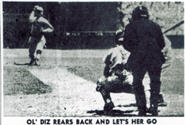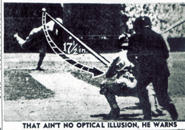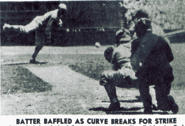Scientist Says Baseball Can Curve 17-1/2 Inches
SCIENTIST SAYS BASEBALL CAN CURVE 17-1/2 INCHES
Dizzy Dean Right: It Ain't No Optical Illusion for Batters!
By WHITNEY SHOEMAKER
Los Angeles (Calif.) Herald & Express, March 28, 1959 (reproduced)
WASHINGTON, March 28--A baseball really does curve. Take the government's word for it.
But take with a grain of salt those swing and miss batters who swear that blasted third strike was a curve that broke two feet.
The most that even a master like Whitey Ford of the New York Yankees can bend a pitch is 17-1/2 inches.
That's straight dope from Dr. Lyman J. Briggs, eminent scientist and baseball buff.
OPTICAL ILLUSION
There was a time when skeptics scoffed at the notion a baseball actually curved. This provoked Dizzy Dean.
"All right," he once challenged, "go stand behind a tree and I'll hit you with an optical illusion."
Not too many years ago, Fat Freddy Fitzsimmons, then of the Brooklyn Dodgers, threw a ball around the second of three stakes set up in a straight line to prove his curve was no illusion.
Now Briggs spoke up for the government. He is director emeritus of the National Bureau of Standards and was active head of this research and testing agency from 1933 to 1945.
MISSILE DATA
In his 84 years Briggs has probed into things ranging from golf balls to atomic fission. He recently delved into baseball for two reasons:
1. He sought data on the flight of low-speed missiles, and 2, he never could hit a curve and is still unhappy about it.
To make his case, Briggs shot rotating baseballs with an air gun and plunked them into a wind tunnel at the bureau.
From all these observations, Briggs concluded:
--The maximum curve a pitcher can achieve in the 60 feet 6 inches from pitcher's mound to home plate is 17-1/2 inches. To do that he has to rotate the ball perfectly sidewise, like spinning a plate flat on a table. Since a pitcher usually snaps his wrist at an angle, he gets less than the maximum curve.
SNAP COUNTS
--The best speed for the most curve is about 100 feet a second. Any big leaguer can do that.
--Speed has little effect on the amount of curve. In other words, Stu Miller of the Giants can play as many tricks with his soft pitch as Bob Turley of the Yankees with his fast one.
--That 17-1/2-inch sweep requires 1,800 revolutions per minute, or about 18 spins from mound to plate. Not many can snap the ball that hard. And the faster it's thrown, the less time the forces creating the curve have to act.

OL' DIZ REARS BACK AND LETS HER GO

THAT AIN'T NO OPTICAL ILLUSION, HE WARNS

BATTER BAFFLED AS CURVE BREAKS FOR STRIKE
Science backed up the baseball curve today. Dr. Lyman Briggs of National Bureau of Standards says he has proof a curve can break a maximum of 17-1/2 inches, following scientific tests. "Ball can't curve?" scoffed famed ex-Card ace Dizzy Dean. "Shucks, get behind a tree and I'll hit you with an optical illusion." Here Dean, in his prime, demonstrates his potent curve.

